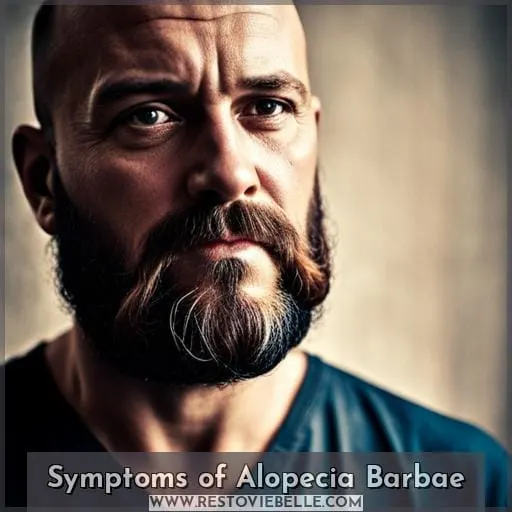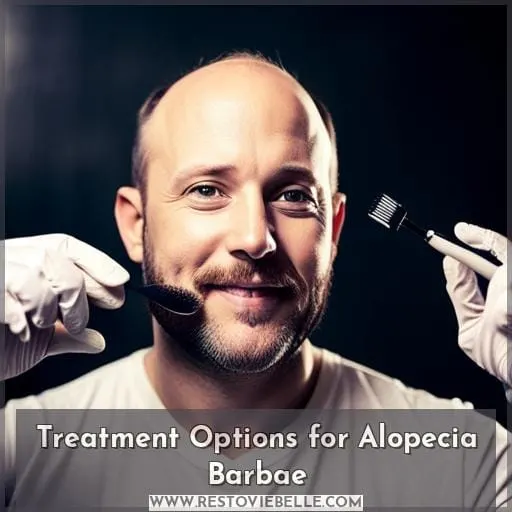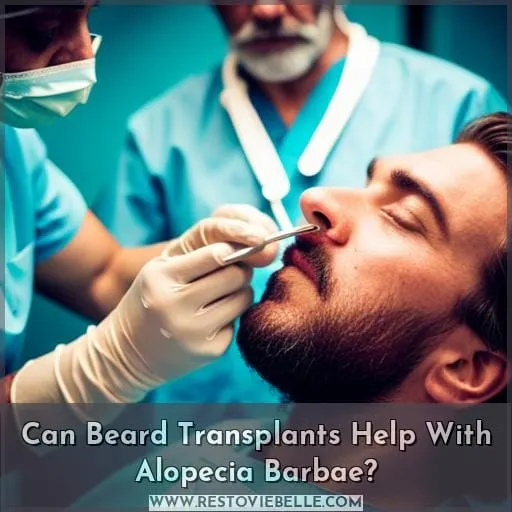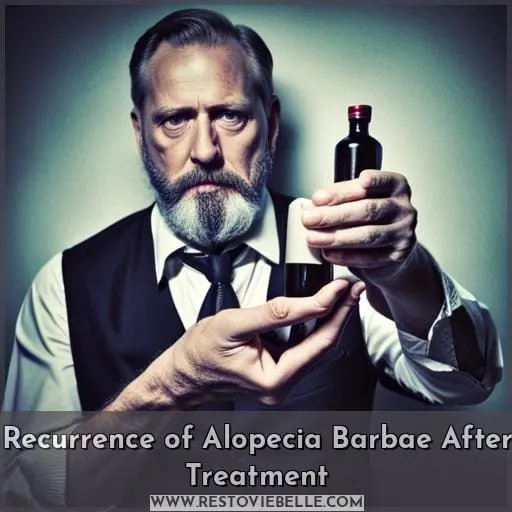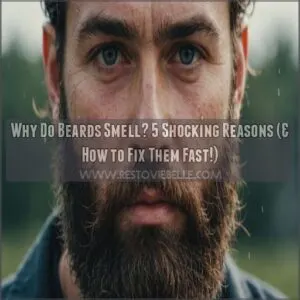This site is supported by our readers. We may earn a commission, at no cost to you, if you purchase through links.
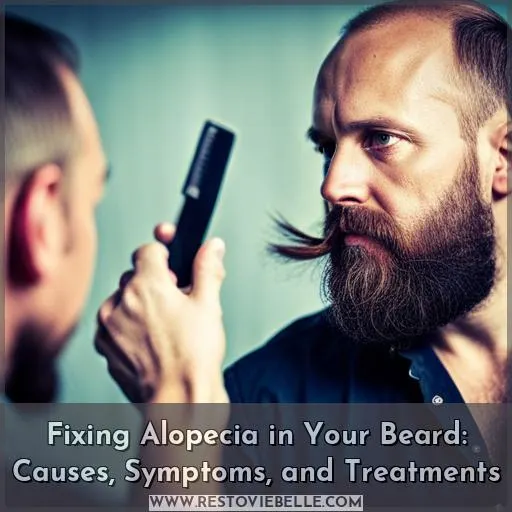 Imagine looking in the mirror and noticing a bald spot in your beard. It can be frustrating and even affect your self-confidence. But don’t worry, you’re not alone. Alopecia in the beard, also known as alopecia barbae, is a common condition that causes hair loss specifically on the face.
Imagine looking in the mirror and noticing a bald spot in your beard. It can be frustrating and even affect your self-confidence. But don’t worry, you’re not alone. Alopecia in the beard, also known as alopecia barbae, is a common condition that causes hair loss specifically on the face.
In this article, we will explore the causes, symptoms, and various treatments available to help you fix alopecia in your beard and regain that full facial hair you desire.
Table Of Contents
- Key Takeaways
- Understanding Alopecia Barbae
- Symptoms of Alopecia Barbae
- Causes and Risk Factors of Alopecia Barbae
- Diagnosing Alopecia Barbae
- Treatment Options for Alopecia Barbae
- Platelet-Rich Plasma (PRP) Treatment for Alopecia Barbae
- Living With Alopecia Barbae
- Can Beard Transplants Help With Alopecia Barbae?
- Recurrence of Alopecia Barbae After Treatment
- Frequently Asked Questions (FAQs)
- How long does it typically take for hair to regrow after starting treatment for Alopecia Barbae?
- Are there any specific dietary changes or supplements that can help with hair regrowth in Alopecia Barbae?
- Can stress or emotional factors contribute to the development or worsening of Alopecia Barbae?
- Are there any alternative or experimental treatments currently being studied for Alopecia Barbae?
- Is there a higher risk of developing other autoimmune conditions if you have Alopecia Barbae?
- Conclusion
Key Takeaways
- Circular bald patches in the beard are a common symptom of alopecia barbae.
- Autoimmune response and triggers or associated conditions are some of the causes and risk factors of alopecia barbae.
- Diagnosing alopecia barbae typically involves a physical examination, scalp biopsy, and blood tests.
- Treatment options for alopecia barbae include medications, immunotherapy, and platelet-rich plasma treatment.
Understanding Alopecia Barbae
Understanding Alopecia Barbae can be achieved by recognizing its unique characteristics and causes.
This condition is a form of hair loss that specifically affects the beard, resulting in sudden circular bald patches. It occurs due to an autoimmune mechanism where the body’s immune system mistakenly attacks the hair follicles in the beard area.
The exact cause of Alopecia Barbae is still unknown, but it may be triggered by genetic factors and certain environmental triggers.
Symptoms of Alopecia Barbae include:
- Small, circular patches of hair loss along the jawline or other facial areas
- Itching and inflammation
- In some cases, white hairs may remain around the edges of these bald patches
Diagnosing this condition involves a thorough physical examination by a doctor or dermatologist who’ll also consider other potential underlying medical conditions.
Treatment options for Alopecia Barbae include:
- Corticosteroids to suppress immune response (topical or injections)
- Minoxidil (Rogaine) to stimulate hair growth
- Platelet-rich plasma therapy using concentrated blood platelets from your own body
- Diphencyprone (DPCP) or Anthralin which work through skin irritation to promote regrowth
Living with alopecia barbata can have emotional impacts such as decreased self-confidence and increased stress levels due to changes in appearance. Fortunately support groups like those provided by National Alopecia Areata Foundation are available provide necessary guidance on coping mechanisms when dealing with alopecia barbata.
Symptoms of Alopecia Barbae
When it comes to Alopecia Barbae, there are several symptoms that you should be aware of:
- One common symptom is the presence of circular bald patches in your beard, which can vary in size and location.
- Another telltale sign is the presence of exclamation mark hairs around these patches.
- Additionally, some individuals may experience itching and tingling sensations in the affected areas.
Circular Bald Patches
You may notice circular bald patches on your beard, caused by Alopecia Barbae. These patches are a result of hair follicles being attacked by the body’s immune system.
Along with the loss of hair, you might experience itching sensations and find exclamation hairs surrounding the bald patches.
Various treatments exist for Alopecia Barbae, but their effectiveness can vary.
Exclamation Mark Hairs
Look out for the presence of exclamation mark hairs, as this is a common symptom of Alopecia Barbae.
Exclamation mark hairs are short, stubby hairs that taper at the base and resemble an exclamation point.
If you notice these hairs in your beard, it’s important to seek medical attention for proper diagnosis and treatment options.
Itching and Tingling
If you experience itching and tingling sensations in your beard, it may be a symptom of Alopecia Barbae.
Itching and tingling are common symptoms associated with this autoimmune condition that causes hair loss. Finding relief methods for these symptoms is crucial as they can have a psychological impact.
Treatment effectiveness, lifestyle adjustments, and support networks play important roles in managing Alopecia Barbae.
Causes and Risk Factors of Alopecia Barbae
Now let’s explore the causes and risk factors of Alopecia Barbae.
This condition is primarily caused by an autoimmune response, where the body mistakenly attacks its own hair follicles in the beard area.
While the exact trigger for this immune response is unknown, it can be influenced by factors such as injury, shock, or other autoimmune diseases.
Additionally, having a family history of alopecia or pre-existing autoimmune conditions can increase your risk of developing Alopecia Barbae.
Autoimmune Response
The autoimmune response is the primary cause of Alopecia Barbae, leading to hair loss in the beard.
Triggers and causes of this condition include:
- Injury
- Shock
- Other autoimmune diseases
- A family history of alopecia
The emotional impact can be significant for those affected by this autoimmune disease.
Support options such as therapy or support groups are available for individuals dealing with Alopecia Barbae.
Triggers and Associated Conditions
To understand the causes and risk factors of Alopecia Barbae, it’s important to recognize the potential triggers and associated conditions that contribute to this autoimmune response.
These triggers include:
- Stress
- Fungal infections (such as ringworm)
- Trauma
- Smoking
- Vitamin deficiencies
- Chemotherapy or cancer treatment-induced alopecia.
Understanding these factors can help in managing and preventing beard hair loss effectively.
| Triggers | Associated Conditions |
|---|---|
| Stress | Atopic Dermatitis |
| Fungal Infections | Vitiligo |
| Trauma |
Stress
Smoking
Vitamin Deficiencies
Family History
Having a family history of alopecia increases your risk for developing Alopecia Barbae.
- There’s a genetic predisposition and susceptibility to this condition.
- People with a family history are at an increased risk.
- The inheritance pattern of Alopecia Barbae is still unknown, but having affected relatives raises concerns.
- Genetic testing may be available to determine the likelihood of developing alopecia based on family history.
Diagnosing Alopecia Barbae
When diagnosing Alopecia Barbae, a doctor or dermatologist will typically:
- Conduct a physical examination to assess the extent of hair loss and examine any bald patches.
- In some cases, perform a scalp biopsy to analyze hair samples under a microscope and rule out other possible conditions.
- Conduct blood tests to check for underlying medical issues such as autoimmune disorders or thyroid problems that could contribute to the development of alopecia in your beard.
The goal is to accurately diagnose Alopecia Barbae by excluding other potential causes of hair loss before determining appropriate treatment options.
Physical Examination
When diagnosing alopecia barbae, your doctor will perform a physical examination.
- Inspecting the affected area for bald spots.
- Examining the surrounding hair follicles using a microscope.
In some cases, they may also conduct scalp biopsies and blood tests to rule out other causes of hair loss through exclusion.
The results of these examinations help in making an accurate diagnosis and determining appropriate treatment options for alopecia barbae.
Scalp Biopsy and Blood Tests
If you suspect Alopecia Barbae, your doctor may recommend a scalp biopsy and blood tests to aid in the diagnosis.
A scalp biopsy involves removing a small piece of skin from the affected area for analysis.
Blood tests can help rule out underlying medical conditions and autoimmune disorders that may be causing the hair loss.
While these procedures are generally safe, there are potential risks such as pain, infection, or scarring.
The cost of a biopsy can vary depending on factors like location and healthcare provider. It’s advisable to check with your insurance provider regarding coverage for these tests.
After a scalp biopsy, it typically takes about one week for the incision site to heal completely with proper aftercare measures such as keeping it clean and avoiding excessive sun exposure or physical activity that could disrupt healing.
Exclusion of Other Conditions
To diagnose Alopecia Barbae, doctors often perform a scalp biopsy and blood tests to exclude other conditions.
These tests help rule out underlying medical issues such as thyroid disorders, fungal infections, autoimmune diseases, or other forms of alopecia like scarring alopecia.
Excluding these conditions is crucial for accurate diagnosis and determining the appropriate treatment for Alopecia Barbae.
Treatment Options for Alopecia Barbae
When it comes to treating alopecia barbae, there are several options available.
Medications such as corticosteroids can help suppress the immune system and promote hair growth.
Immunotherapy, including contact immunotherapy and platelet-rich plasma treatment, have also shown success in stimulating regrowth in some cases.
It’s important to consult with a healthcare professional to determine the most suitable treatment option based on your individual circumstances and severity of hair loss.
Medications
To treat Alopecia Barbae, your doctor may prescribe various medications.
These medications aim to promote hair regrowth by addressing the underlying autoimmune response.
Corticosteroids, such as creams or injections, are commonly used to suppress the immune system and stimulate hair growth. However, they may have side effects and require careful monitoring of dosage and duration of use.
Other treatment options include immunotherapy with allergens like Diphencyprone (DPCP) or Anthralin to irritate the skin and trigger hair regrowth.
The efficacy of these medications can vary among individuals, so it’s important to consult a dermatologist for personalized guidance based on your specific condition.
Immunotherapy
Now let’s explore an effective treatment option for Alopecia Barbae. Immunotherapy can stimulate hair regrowth by triggering an allergic skin reaction.
This treatment involves applying a topical solution, such as diphencyprone (DPCP), to the affected areas of the beard. The solution causes mild irritation and inflammation, which in turn stimulates hair growth.
Immunotherapy has shown promising results in treating Alopecia Barbae, with success rates varying from person to person. However, it’s important to note that immunotherapy may have some side effects like redness or itching at the application site.
The duration and cost of this treatment will depend on individual circumstances and preferences.
Platelet-Rich Plasma (PRP) Treatment for Alopecia Barbae
If you’re considering treatment options for Alopecia Barbae, one potential option to explore is Platelet-Rich Plasma (PRP) therapy.
PRP treatment involves injecting a concentrated solution of your own platelets into the affected areas of your beard. These platelets contain growth factors that can stimulate hair follicles and promote hair regrowth.
The duration of PRP treatment can vary depending on the severity and response to therapy, with multiple sessions typically required over several months.
As with any medical procedure, there are potential side effects of PRP treatment, including temporary redness or swelling at the injection site.
The cost of PRP treatment may also vary depending on factors such as location and provider expertise but generally ranges from $500 to $1500 per session.
When it comes to efficacy, studies have shown promising results in using PRP for treating alopecia barbae; however, individual responses may vary.
It’s important to note that while this non-invasive procedure carries minimal risks when performed by a trained professional in a sterile environment,
it’s always advisable to consult with an experienced dermatologist or trichologist before undergoing any treatments for Alopecia Barbae
Living With Alopecia Barbae
Living with Alopecia Barbae can be challenging, but there are ways to manage and cope with this condition.
It’s important to acknowledge the emotional impact that hair loss can have on your mental health and self-image. Dealing with the physical changes caused by Alopecia Barbae may lead to feelings of insecurity, low self-esteem, or even depression.
However, it’s essential to remember that you aren’t alone in this journey. Support groups and therapy sessions can provide a safe space for sharing experiences and finding encouragement from others who understand what you’re going through.
Additionally, addressing social stigma associated with hair loss is crucial for maintaining a positive outlook on life. Education about alopecia among family members, friends, coworkers, or classmates may help alleviate misunderstandings or negative perceptions surrounding your appearance.
Remember that living well despite Alopecia Barbae starts from within – taking care of your mental health will greatly contribute towards embracing yourself fully as you navigate life’s challenges while managing this condition
Can Beard Transplants Help With Alopecia Barbae?
To address the issue of Alopecia Barbae and potential solutions, you may be wondering if beard transplants can help with this condition. Beard transplants are a surgical procedure that involves transplanting hair follicles from other areas of your body to the bald patches in your beard.
This can be an effective solution for individuals experiencing Alopecia Barbae who desire a full and healthy-looking beard.
The process begins with a consultation where the surgeon evaluates your specific case and discusses expectations, including cost of beard transplant, results, recovery time, aftercare instructions,and timeline.
During the procedure itself, hair follicles are extracted from donor sites such as the back or sides of your scalp using either FUE (Follicular Unit Extraction) or FUT (Follicular Unit Transplantation) techniques.
After transplantation is complete,you will need to follow proper aftercare instructions provided by your surgeon to ensure successful healing and minimize complications.The recovery period typically lasts around 7-10 days before you can resume normal activities.
It’s important to note that while results vary among individuals,the majority experience significant improvement in their facial hair density within several months following surgery.With advancements in technology,a skilled surgeon can provide natural-looking results that restore confidence.
Recurrence of Alopecia Barbae After Treatment
After treatment, it’s important to monitor for the recurrence of Alopecia Barbae, as it can sometimes reoccur.
While there’s no definitive cure for this condition, various treatments are available to help manage and promote hair regrowth. The effectiveness of these treatments varies depending on factors such as the severity of the condition and individual response.
It’s crucial to identify any triggers that may have contributed to the initial onset of Alopecia Barbae in order to minimize the risk of recurrence. Additionally, maintaining a healthy lifestyle and managing stress levels can also play a role in preventing or reducing future episodes.
Recovery time after treatment will vary from person to person, with some individuals experiencing partial or full regrowth within months while others may require longer periods for noticeable improvement.
Regular follow-ups with healthcare professionals will allow them to assess progress and provide guidance on ongoing management strategies based on individual needs.
Frequently Asked Questions (FAQs)
How long does it typically take for hair to regrow after starting treatment for Alopecia Barbae?
Hair regrowth after starting treatment for Alopecia Barbae can vary.
On average, it may take several months to a year for noticeable improvements. However, individual results depend on factors like the severity of hair loss and the effectiveness of the chosen treatment method.
Are there any specific dietary changes or supplements that can help with hair regrowth in Alopecia Barbae?
To promote hair regrowth in Alopecia Barbae, consider incorporating:
- A nutrient-rich diet with foods high in zinc and biotin.
- Supplements like marine extracts, which may aid in stimulating hair growth.
Consult with your healthcare provider for personalized recommendations.
Can stress or emotional factors contribute to the development or worsening of Alopecia Barbae?
Stress and emotional factors can potentially contribute to the development or worsening of Alopecia Barbae.
While the exact mechanisms aren’t fully understood, managing stress levels through techniques like relaxation exercises may help improve symptoms.
Are there any alternative or experimental treatments currently being studied for Alopecia Barbae?
Alternative and experimental treatments for Alopecia Barbae are actively being researched, providing hope for those seeking new solutions.
One interesting statistic reveals that stem cell therapy shows promise in stimulating hair regrowth, offering a potential breakthrough in the future of treating this condition.
Is there a higher risk of developing other autoimmune conditions if you have Alopecia Barbae?
Having Alopecia Barbae doesn’t necessarily increase your risk of developing other autoimmune conditions. However, individuals with one autoimmune disease may be more prone to others, so it’s important to monitor your health and seek appropriate medical care.
Conclusion
To fix alopecia in your beard, it’s important to understand the causes, symptoms, and treatment options available.
Alopecia barbae, or hair loss in the beard, can be frustrating, but there are ways to address it.
Medications, immunotherapy, and platelet-rich plasma treatment are just a few options to consider.
It’s also important to remember that living with alopecia barbae is possible, and beard transplants can be a potential solution.
While there may be a risk of recurrence, taking action and exploring treatment options can help you regain the full and confident beard you desire.


